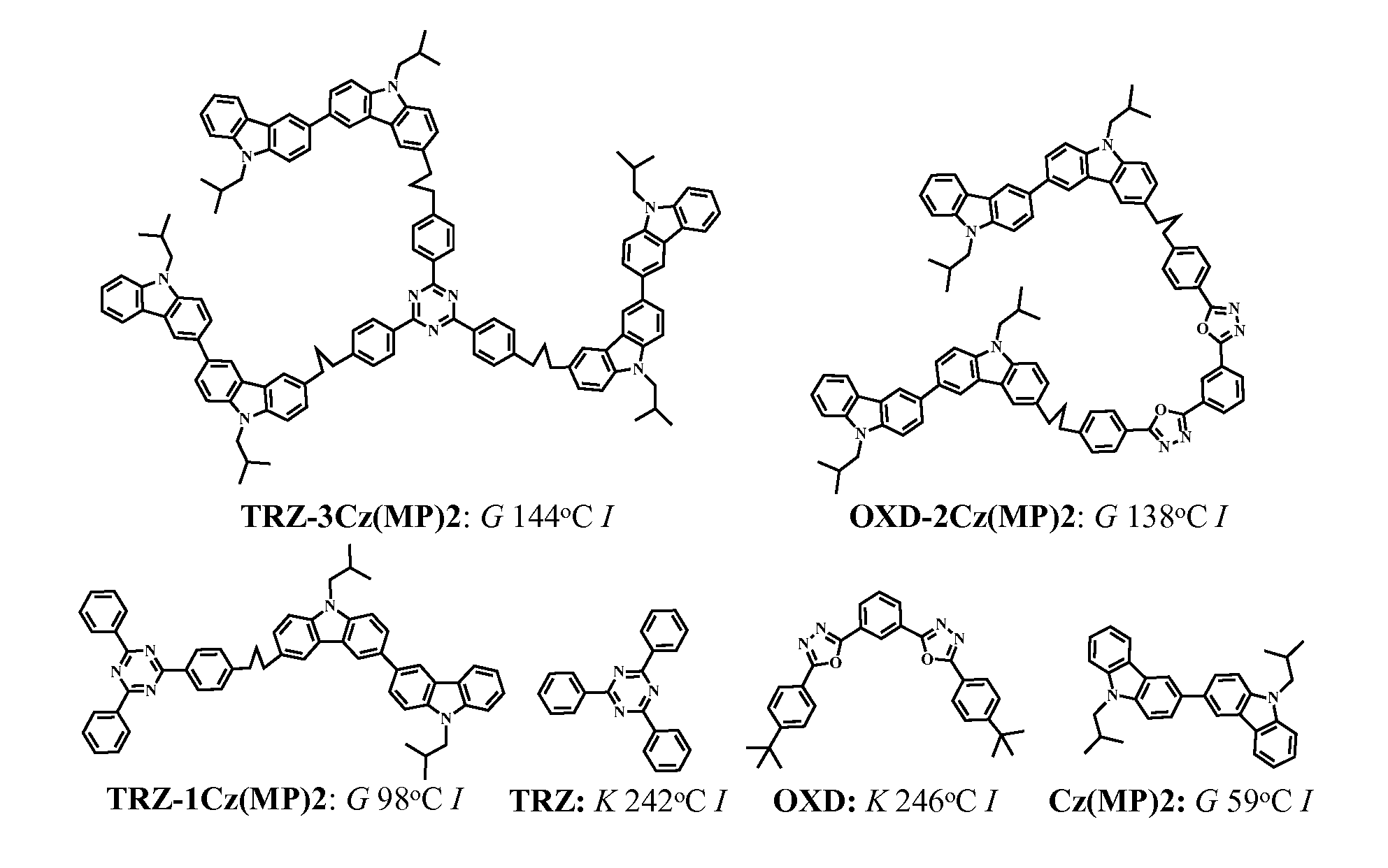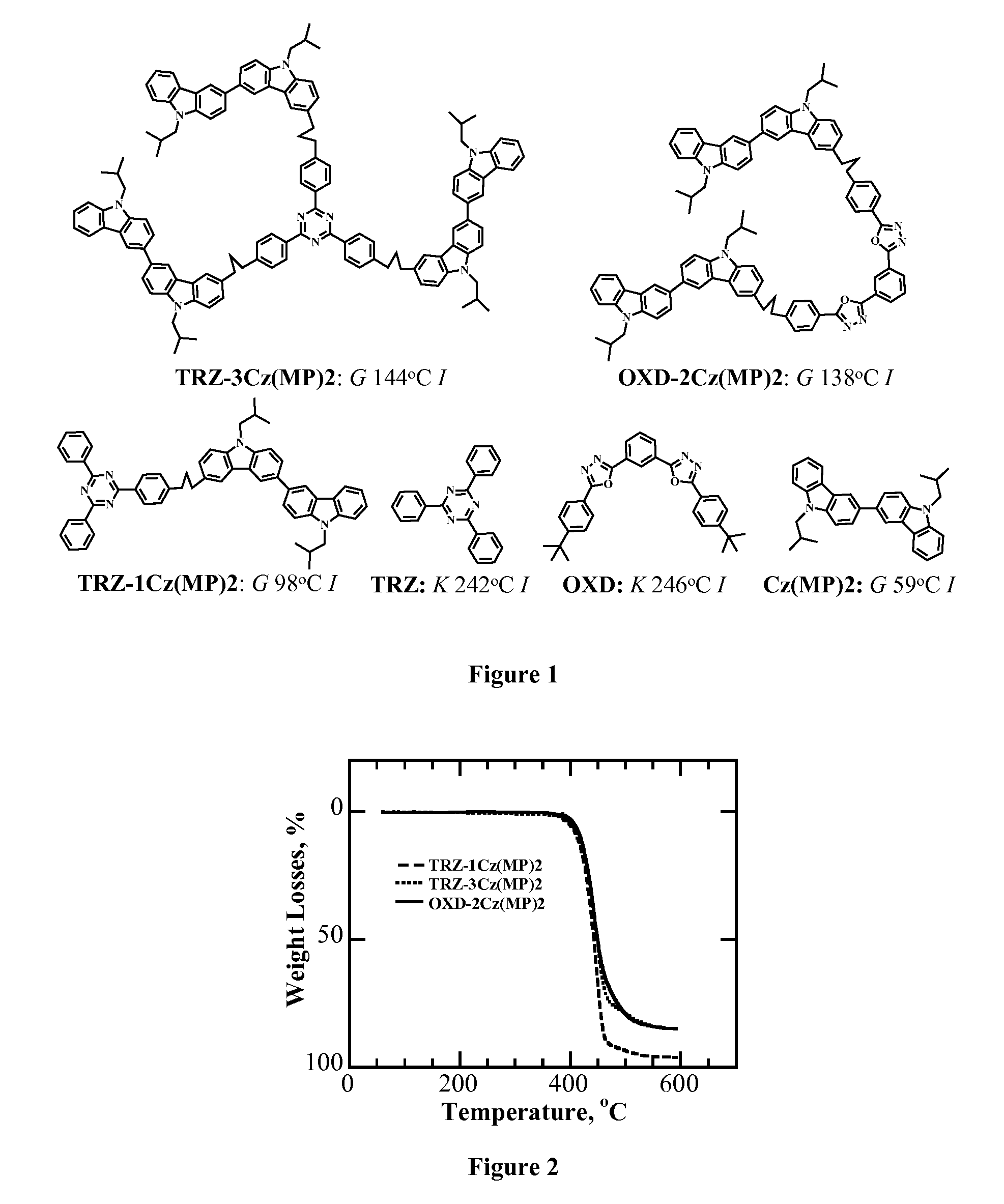Hybrid Host Materials For Electrophosphorescent Devices
a technology of host materials and electrophosphorescent devices, applied in the field of hybrid host materials for electrophosphorescent devices, can solve the problems of narrow recombination zone, affecting the operation stability of the device, and reducing the efficiency and lifetime of the device, so as to improve the efficiency and lifetime improve the stability of the oled device, and increase the stability. the effect of crystallization stability
- Summary
- Abstract
- Description
- Claims
- Application Information
AI Technical Summary
Benefits of technology
Problems solved by technology
Method used
Image
Examples
example 1
Synthesis and Characterization of Specific Compounds of the Present Invention
[0055]Material Synthesis and Characterization. 1H NMR spectra were acquired in CDCl3 with an Avance-400 spectrometer (400 MHz) at 298° K. using trimethylsilane (TMS) as an internal standard. Elemental analysis was carried out by Quantitative Technologies, Inc. All chemicals, reagents, and solvents were used as received from commercial sources without further purification except toluene and tetrahydrofuran (THF) that had been distilled over sodium and benzophenone. All reactions were carried out under argon atmosphere and anhydrous conditions unless noted otherwise. Intermediates 9-(2-methylpropyl)carbazole (1), 2-bromo-7-methoxy-9-methylcarbazole (14), 3,6-bis(carbazol-9-yl)carbazole (16), 2,4,6-tris(4-bromophenyl)-1,3,5-triazine, 2-(4-bromophenyl)-4,6-biphenyl-1,3,5-triazine, 1,3,5-tris(4-bromophenyl)benzene, 1,3-bis(5-(4-bromophenyl)-1,3,4-oxadiazole-2-yl)benzene, and 3,5-bis(4-bromophenyl)-4-phenyl-1,2,5...
example 2
Properties of Specific Compounds of the Present Invention
[0107]Morphology, Thermal Stability, and Phase Transition Temperatures. Thermogravimetric analysis was performed in a TGA / DSC system (SDT Q600, TA Instruments) at a ramping rate of 10° C. / min under a nitrogen flow of 50 ml / minute. Thermal transition temperatures were determined by differential scanning calorimetry (Perkin-Elmer DSC-7) with a continuous N2 purge at 20 ml / minute. Samples were preheated to above Tm and then cooled down to −30° C. at −100° C. / minute before the reported second heating and cooling scans were recorded at 20° C. / minute. The nature of phase transition was characterized by hot-stage polarizing optical microscopy (DMLM, Leica, FP90 central processor and FP82 hotstage, Mettler Toledo). Absorption spectra of dilute solutions in chloroform at a concentration of 10−7 to 10−6 M were acquired on a UV-Vis-NIR spectrophotometer (Lambda-900, Perkin-Elmer).
[0108]Electrochemical Characterization. Cyclic voltammetry...
PUM
| Property | Measurement | Unit |
|---|---|---|
| triplet energy | aaaaa | aaaaa |
| triplet energy | aaaaa | aaaaa |
| unoccupied molecular orbital energy | aaaaa | aaaaa |
Abstract
Description
Claims
Application Information
 Login to View More
Login to View More - R&D
- Intellectual Property
- Life Sciences
- Materials
- Tech Scout
- Unparalleled Data Quality
- Higher Quality Content
- 60% Fewer Hallucinations
Browse by: Latest US Patents, China's latest patents, Technical Efficacy Thesaurus, Application Domain, Technology Topic, Popular Technical Reports.
© 2025 PatSnap. All rights reserved.Legal|Privacy policy|Modern Slavery Act Transparency Statement|Sitemap|About US| Contact US: help@patsnap.com



